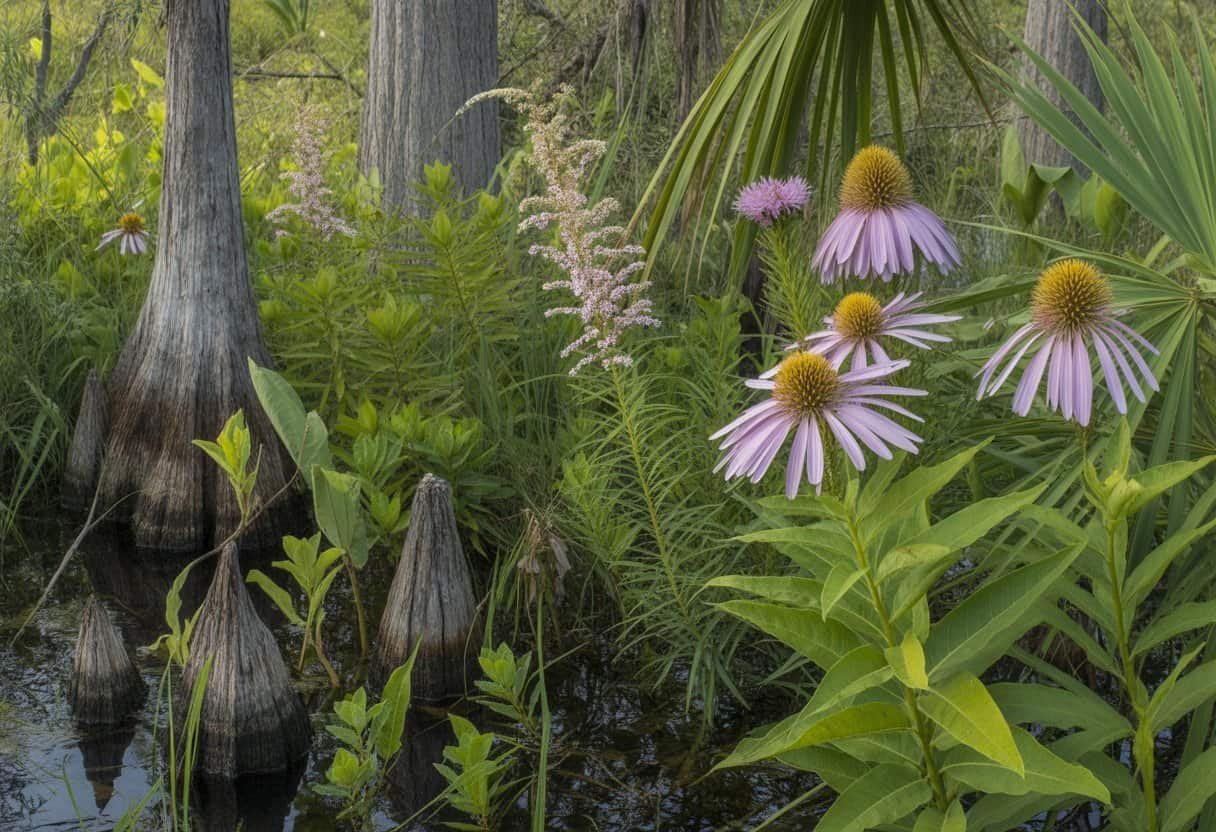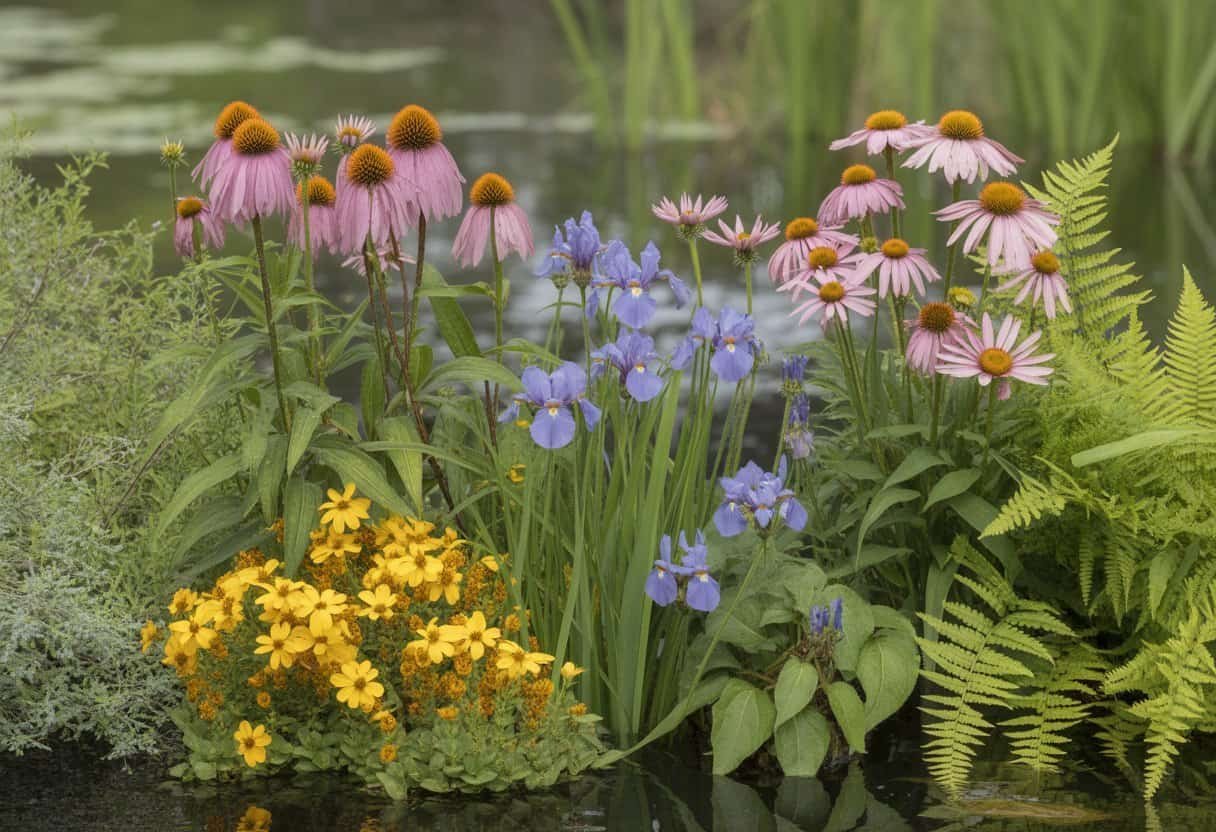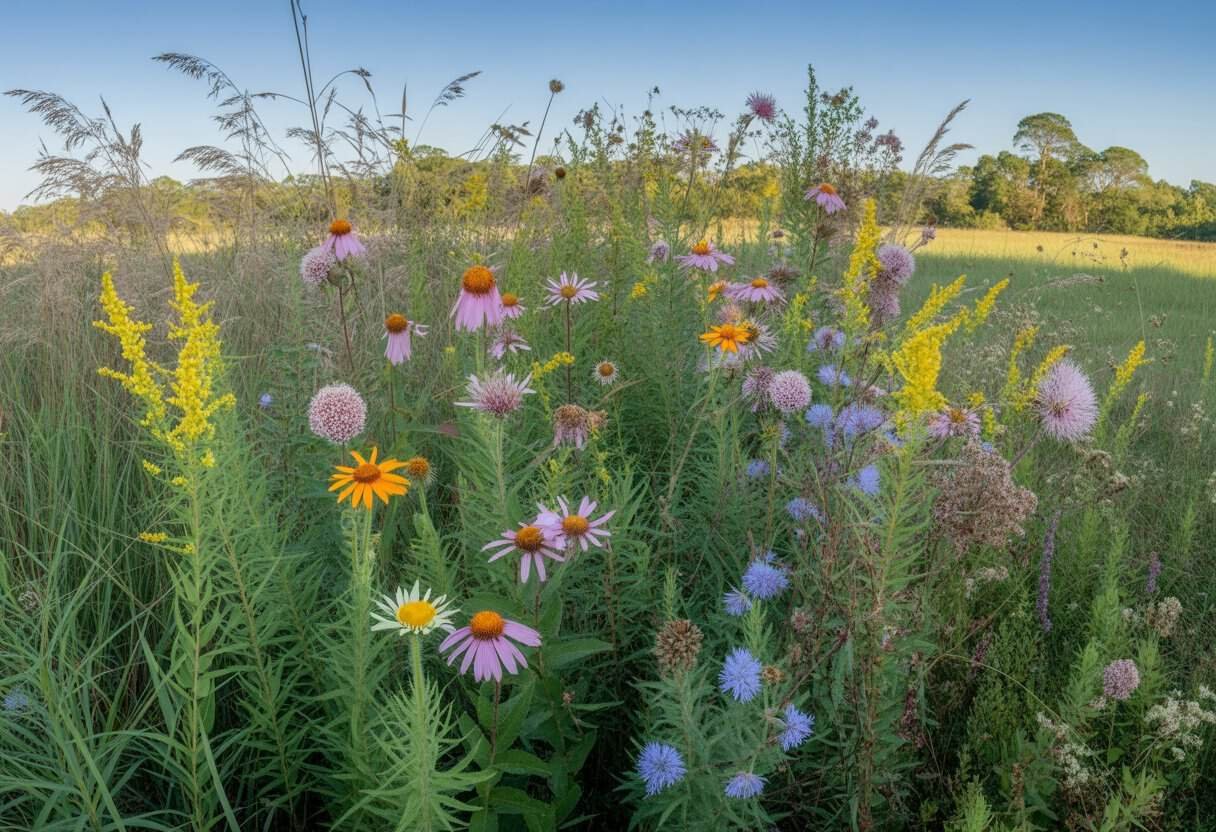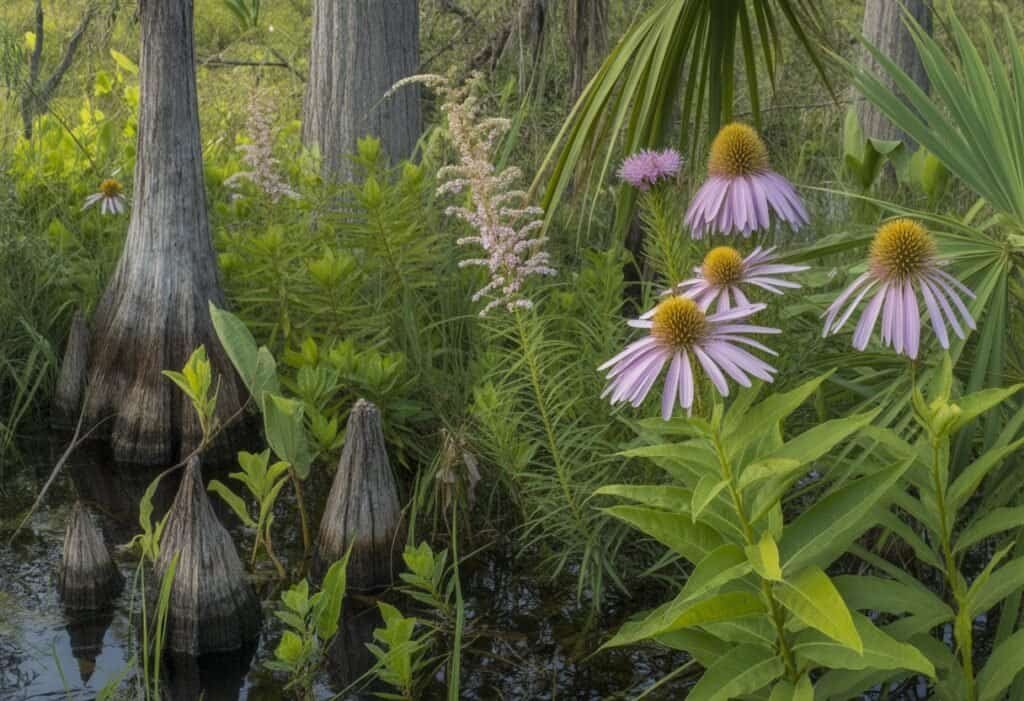Louisiana native plants add local beauty and history to any garden. These plants have grown in our state for thousands of years and have adapted to our unique climate and soil.
Using native plants in your garden supports local wildlife, reduces maintenance, and creates a sustainable landscape that connects to Louisiana’s natural heritage.

From the elegant Louisiana iris to the sturdy bald cypress tree, our state offers an incredible variety of native plants. They thrive in our hot, humid summers and mild winters.
Many Louisiana natives offer beautiful blooms, interesting textures, and seasonal colors that make gardens more attractive.
Key Takeaways
- Louisiana native plants need less water, fertilizer, and maintenance than non-native species once established.
- Native plants provide food and habitat for local wildlife, including birds, butterflies, and beneficial insects.
- Adding natives to your landscape helps preserve Louisiana’s botanical heritage and creates a unique sense of place.
Understanding Louisiana Native Plants
Louisiana’s ecosystem thrives with diverse native plants that evolved to flourish in the state’s unique climate and soil. These plants form the foundation of local habitats and provide resources for wildlife.
Definition and Importance
Native plants grow naturally in a region without human introduction. In Louisiana, these plants evolved alongside local wildlife, creating interdependent relationships.
They need less maintenance than non-native species because they’re adapted to Louisiana’s humidity, rainfall, and soil. Louisiana native plants like bald cypress, southern magnolia, and Louisiana iris support local pollinators and wildlife with food and shelter.
They help prevent erosion along Louisiana’s coastlines and waterways.
Many species are found nowhere else in the world, making them vital to the state’s biodiversity and cultural identity.
Native Plant Ecosystems
Louisiana hosts several distinct ecosystems where native plants thrive. Bottomland hardwood forests feature water-tolerant species like tupelo and oak trees that handle periodic flooding.
Coastal prairies, once widespread in southwestern Louisiana, support diverse grasses and wildflowers suited to the region’s conditions. Though rare today, these prairies remain important biodiversity hotspots.
Louisiana’s wetlands contain specialized plant communities adapted to constant moisture. Marsh grasses, water lilies, and bald cypress trees create complex habitats in these areas.
Pine savannas in the Florida Parishes feature longleaf pines and diverse understory plants that depend on regular fires. Without these natural cycles, many native plant species struggle to reproduce.
Popular Native Plant Species of Louisiana

Louisiana’s ecosystems support many beautiful native plants that thrive in the state’s climate. These plants provide habitat for wildlife and need less maintenance than non-native species.
American Beautyberry (Callicarpa americana)
American Beautyberry is a striking deciduous shrub found throughout Louisiana. It grows 3-8 feet tall and spreads 4-8 feet wide, making it perfect for gardens and natural landscapes.
Its brilliant purple berries cluster tightly around stems in fall. These fruits persist after leaves drop and provide winter food for over 40 species of birds.
White flowers appear in spring and summer and attract butterflies and pollinators. Beautyberry prefers partial shade but adapts to full sun with enough moisture.
This hardy plant tolerates poor soil and resists most pests and diseases. Native Americans used the leaves as insect repellent by crushing them to release mosquito- and tick-deterring compounds.
Southern Magnolia (Magnolia grandiflora)
Southern Magnolia is Louisiana’s state flower and symbolizes the region’s natural beauty. This evergreen tree grows 60-80 feet tall with a spread of 30-50 feet at maturity.
Its large, glossy leaves have rusty-brown undersides and provide year-round greenery. The fragrant white flowers measure 8-12 inches across and bloom from May through June, with some flowers appearing later in summer.
The tree produces cone-like seed pods that reveal bright red seeds in fall. These seeds attract birds and small mammals.
Southern Magnolias thrive in full sun to partial shade and prefer well-drained, acidic soils. Their deep roots make them very wind-resistant during hurricanes and storms.
These long-lived trees can survive for 80-120 years, providing shade, wildlife habitat, and beauty for generations.
Bald Cypress
Bald Cypress trees define Louisiana’s swamps and wetlands. They are deciduous conifers and shed their feathery needles each fall, turning rusty orange before dropping.
The trees develop “knees” – woody projections that rise from the roots in wet areas. These knees help provide oxygen to the root system and add stability in soggy soils.
Mature trees reach 50-100 feet tall with flared bases that anchor them in wetlands. Their trunks can become massive, with some ancient trees over 6 feet across.
Bald Cypress thrives in standing water but also grows well in dry upland sites. The wood resists rot and was historically valuable for construction.
Native Americans used cypress for canoes, and early settlers built homes and furniture from this durable timber.
Purple Coneflower (Echinacea purpurea)
Purple Coneflower brings vibrant color to Louisiana gardens from late spring through summer. This drought-tolerant perennial grows 2-4 feet tall with sturdy stems and rough, lance-shaped leaves.
The flowers have drooping purple-pink petals around a spiky orange-brown center cone. These blooms last several weeks and attract butterflies, bees, and hummingbirds.
After flowering, the seed heads remain through winter and feed goldfinches and other songbirds. These dried seed heads also add winter interest to the garden.
Native Americans and early settlers valued Purple Coneflower for medicinal purposes. Today, echinacea remains popular in herbal supplements.
This low-maintenance plant thrives in full sun and tolerates poor soil. Once established, it needs little water and will spread gradually by self-seeding.
Wildflowers and Grasses Native to Louisiana

Louisiana’s ecosystems support a remarkable variety of native wildflowers and grasses. These plants have adapted to the state’s soil and climate, providing habitat for local wildlife and adding natural beauty.
Black-eyed Susan (Rudbeckia hirta)
Black-eyed Susan is one of Louisiana’s most recognizable native wildflowers. This bright yellow daisy-like flower has a dark brown center and grows 1-3 feet tall.
The plant thrives in full sun and adapts to many soil types, making it versatile for Louisiana habitats. Black-eyed Susan blooms from June through September, providing long-lasting color.
Wildlife benefits from this plant. Bees, butterflies, and other pollinators visit the flowers for nectar, while birds eat the seeds in fall and winter.
Black-eyed Susan is drought-tolerant once established and needs minimal maintenance in home gardens. It self-seeds readily and creates natural colonies when given space.
Louisiana Iris Species
Louisiana irises are some of the state’s most beautiful native flowering plants. The group includes five species, with Iris fulva (copper iris) and Iris brevicaulis (zigzag iris) being especially common.
These irises grow in wetlands, swamps, and along stream banks. They produce blooms in deep purples, blues, coppery reds, and creamy whites, usually flowering from March to May.
Key Louisiana Iris Species:
- Iris fulva (Copper iris) – Rusty red flowers
- Iris brevicaulis (Zigzag iris) – Blue-purple blooms
- Iris giganticaerulea (Giant blue iris) – Large blue flowers
Louisiana irises prefer moist, slightly acidic soil and partial sun. They spread through rhizomes to form colonies and create dramatic displays in suitable habitats.
Swamp Milkweed and Frogfruit
Swamp milkweed (Asclepias incarnata) thrives in Louisiana’s wet areas. It grows 3-5 feet tall with clusters of pink flowers that bloom from June to August.
This native plant is a host for monarch butterflies. The milkweed’s hollow stems provide nesting material for native bees, and its flowers offer nectar for many pollinators.
Frogfruit (Phyla nodiflora) forms low-growing mats with tiny white to pale lavender flowers. It serves as a groundcover in moist areas and tolerates light foot traffic.
Frogfruit blooms from spring through fall, providing resources for small pollinators. It also acts as a larval host plant for several butterfly species, including the common buckeye.
Native Grasses
Louisiana’s native grasses form the backbone of many ecosystems, from prairies to coastal marshes. These grasses provide erosion control, wildlife habitat, and year-round visual interest.
Common Native Louisiana Grasses:
- Switchgrass (Panicum virgatum) – Upright blue-green foliage with airy seedheads
- Gulf Muhly (Muhlenbergia capillaris) – Dramatic pink-purple plumes in fall
- Inland Sea Oats (Chasmanthium latifolium) – Distinctive dangling seedheads
Native grasses offer multi-season appeal. Their summer growth provides nesting sites for birds, and winter seed heads supply food.
Native grasses need minimal maintenance once established. Most species benefit from being cut back once a year in late winter before new growth starts.
These grasses adapt to tough conditions. Some tolerate flooding, while others handle drought, making them valuable in restoration projects throughout Louisiana.
Native Shrubs and Trees
Louisiana’s landscape features a rich variety of native shrubs and trees that thrive in the state’s warm, humid climate. These plants provide habitat for wildlife and need less maintenance than non-native species once established.
Azalea Varieties
Native azaleas in Louisiana offer stunning spring displays with bright, fragrant blooms. Unlike their Asian relatives, native azaleas are deciduous and more drought-tolerant.
The Florida Flame Azalea (Rhododendron austrinum) produces orange-yellow flowers that attract butterflies and hummingbirds. This species grows well in partially shaded areas with well-drained soil.
The Piedmont Azalea (Rhododendron canescens) displays pink blooms with a sweet fragrance. It can reach 6-8 feet tall and does best in dappled sunlight.
Swamp Azalea (Rhododendron viscosum) features white flowers with a spicy scent and tolerates wetter conditions than other varieties. It’s a good choice for rain gardens or areas with poor drainage.
Hawthorn Species
Hawthorn trees are valuable native plants that add beauty and ecological benefits to Louisiana landscapes.
The Parsley Hawthorn (Crataegus marshallii) stands out with delicate white flowers and finely cut leaves that look like parsley. In fall, it produces bright red berries that persist through winter and feed birds.
Key Hawthorn Benefits:
- Provides nesting sites for birds
- Offers food for wildlife through berries
- Tolerates poor soils
- Resists most diseases and pests
Green Hawthorn (Crataegus viridis) grows to 25-35 feet tall and has glossy green leaves. Its dense branches make it a good windbreak or privacy screen.
Live Oak
The Live Oak (Quercus virginiana) is Louisiana’s most iconic native tree. Specimens can live for centuries.
These majestic trees can grow to 80 feet tall. Their sprawling limbs create canopies spanning 100 feet or more.
Live Oaks thrive in Louisiana’s climate. Their deep roots and flexible wood help them withstand hurricanes.
They prefer full sun. However, they adapt to various soil conditions, including clay.
Live Oaks provide significant environmental benefits. They create cooling shade, reduce energy costs, and support over 500 species of caterpillars, a critical food source for birds.
These trees require minimal care once established. Young trees need regular watering for the first two years, but mature Live Oaks tolerate drought well.
Live Oaks produce acorns that support wildlife like squirrels, deer, and turkeys. Their spreading canopies also create habitats for native epiphytes like Spanish moss.
Ecological Benefits of Native Plants
Native plants in Louisiana support local ecosystems. They create healthy habitats and help maintain the balance of nature that has evolved over thousands of years.
Supporting Wildlife and Habitat
Louisiana’s native plants serve as essential food sources for wildlife. Many animals, including deer, rely on native vegetation they’ve evolved with for generations.
Native plants produce seeds, nuts, and berries that match the nutritional needs of local birds and small mammals. Their growth patterns also provide ideal nesting materials and shelter.
These plants support specialized relationships with pollinators like bees and butterflies. Their flowering times align with the life cycles of these insects.
Native vegetation creates protective cover for ground-dwelling animals. Thickets of native shrubs offer hiding places, while taller trees provide nesting sites for birds and squirrels.
Enhancing Biodiversity
Native plants strengthen Louisiana’s biodiversity by supporting complex food webs. Each species plays a unique role in the ecosystem.
When diverse native plants thrive, they:
- Increase soil health with varied root systems
- Improve water filtration and retention
- Provide different habitat types in one area
- Support specialized insect populations
Areas with native plants host more species of birds, butterflies, and beneficial insects than areas with mostly non-native plants.
Native plant communities show greater resilience to environmental changes. Their genetic diversity helps them adapt to shifting conditions.
Native Plants for Pollinators and Beneficial Insects
Louisiana’s native plants offer essential food and habitat for pollinators. These plants have evolved alongside local insects and birds, creating strong partnerships that support biodiversity.
Attracting Bees and Butterflies
Bees and butterflies flock to many Louisiana native plants. Black-eyed Susans (Rudbeckia hirta) produce bright yellow flowers that attract bees from spring through fall.
Purple coneflower (Echinacea purpurea) serves as a nectar source and host plant for butterflies. Butterfly weed (Asclepias tuberosa) is essential for monarch butterflies, providing nectar and serving as their only host plant.
Plant butterfly weed in sunny, well-drained areas. Native asters and goldenrods bloom in late summer and fall, supporting many native bee species when other nectar sources are scarce.
For butterflies, consider these host plants:
- Passionflower vine – Gulf fritillary butterfly
- Pawpaw trees – Zebra swallowtail butterfly
- Parsley – Black swallowtail butterfly
Plants for Hummingbirds and Moths
Hummingbirds and moths prefer tubular flowers that suit their long feeding structures. Cardinal flower (Lobelia cardinalis) produces vibrant red blooms that attract hummingbirds. This plant thrives in moist areas with partial shade.
Trumpet honeysuckle (Lonicera sempervirens) offers nectar throughout the growing season. This native vine supports wildlife without becoming invasive.
Evening-blooming plants like evening primrose (Oenothera species) attract sphinx moths and other night pollinators. Their pale yellow flowers glow at twilight, guiding moths to nectar.
Louisiana iris varieties provide beauty and ecological benefits. Their unique flowers serve as feeding stations for hummingbirds and larger butterflies.
Pollinator Garden Ideas
To create a pollinator garden, plant clusters of at least three of the same species. This helps pollinators find flowers and collect resources efficiently.
Choose plants with different bloom times to provide food from spring through fall. Early bloomers like redbud trees and wild columbine give pollinators energy after winter.
Avoid pesticides in your garden. Even organic options can harm beneficial insects. Instead, rely on native plants’ natural defenses and the predatory insects they attract.
Add a water source, such as a shallow dish with pebbles, so insects can drink safely. Keep the water fresh to prevent mosquitoes.
Layer your garden with different heights:
- Ground covers like wild ginger
- Mid-height plants like blazing star
- Taller species such as Joe-Pye weed
This structure offers diverse habitat options for pollinators.
Incorporating Native Plants in Gardens and Landscapes
Native Louisiana plants can transform yards into beautiful, sustainable spaces that thrive in the local climate. These plants support wildlife and require less maintenance than non-native alternatives.
Designing Louisiana Gardens
Louisiana gardens shine when they reflect the state’s natural beauty. Observe native plant communities for design inspiration.
Group plants with similar water and light needs to create efficient garden zones. Choose a variety of heights and textures for visual interest.
Tall grasses like Gulf Muhly create movement. Louisiana irises add bold color.
Understory trees such as Eastern Redbud provide dappled shade for woodland plants. Consider seasonal changes in your garden.
Butterfly weed offers summer blooms. American beautyberry provides fall and winter interest with its purple berries.
Leave open areas with shorter plants to create sightlines through your garden.
Flood Resistant Plant Choices
Louisiana’s heavy rainfall requires plants that handle periodic flooding. Many native species evolved for these conditions.
Excellent Flood-Tolerant Options:
- Bald Cypress (Taxodium distichum) – Grows in standing water
- Swamp Sunflower (Helianthus angustifolius) – Bright yellow blooms in fall
- Louisiana Iris (Iris species) – Colorful spring flowers
- River Oats (Chasmanthium latifolium) – Attractive seed heads
These plants develop extensive roots that stabilize soil during heavy rains. They can endure several days of standing water.
For areas that flood regularly, create a rain garden with a slight depression. This feature captures runoff and lets water slowly soak into the soil.
Plant the wettest center with species like Buttonbush. Transition to drier-tolerant plants at the edges.
Best Practices for Planting
Successful native plant gardens start with proper installation. Plant during fall or early spring when temperatures are mild and rainfall is plentiful.
This timing gives roots time to establish before summer heat. Match plants to your specific soil conditions.
Many Louisiana natives prefer acidic soils. Some coastal species tolerate alkaline conditions.
Test your soil before planting. Space plants according to their mature size to prevent overcrowding.
Proper spacing allows plants to develop their natural form. Apply 2-3 inches of mulch around new plantings to retain moisture and suppress weeds.
Pine straw works well for woodland species. Bark mulch suits sunny gardens.
Water deeply but infrequently to encourage deep root growth. Most native plants need regular watering only during their first year or during extreme drought.
Identifying Louisiana Native Plants
Proper identification of Louisiana’s native plants requires knowing both their scientific classifications and visual features. Native plants with white flowers are especially abundant in Louisiana and make excellent decorative choices.
Using Scientific and Common Names
Scientific names identify plants precisely, while common names make them easier to discuss. Each Louisiana native plant has a two-part scientific name of genus and species.
For example, Magnolia grandiflora is the Southern Magnolia, Louisiana’s state flower. Common names often vary by region.
“Spanish Moss” (Tillandsia usneoides) isn’t actually moss but belongs to the bromeliad family. Field guides specific to Louisiana help with identification.
These guides usually list both scientific and common names, photos, and distinguishing features. Local botanical gardens like the LSU AgCenter or Longue Vue House and Gardens offer living collections of labeled native plants.
Notable White Flowers and Decorative Uses
Louisiana’s native white-flowered plants add elegant beauty to landscapes. The Louisiana White Star (Amsonia tabernaemontana) produces clusters of star-shaped white flowers in spring.
This drought-tolerant perennial grows 2-3 feet tall and works well in borders. White Wild Indigo (Baptisia alba) features tall spikes of white pea-like flowers that bloom in late spring.
The plant reaches 3-4 feet in height and adds architectural interest. Cherokee Rose (Rosa laevigata) displays large white flowers with yellow centers.
Though technically introduced, it has naturalized throughout Louisiana. White flowering natives excel in moon gardens that glow during evening hours.
They also create striking effects when planted in groups along woodland edges or in rain gardens. Many white-flowered natives attract pollinators like butterflies and native bees.
Native Plants Maintenance and Conservation
Preserving Louisiana’s native plants requires proper care in gardens and protection of wild habitats. These approaches help maintain biodiversity and ensure native plants continue to thrive.
Sustainable Gardening Tips
Native plants generally need less maintenance than non-native species. Water new plants regularly until established, then reduce watering as most Louisiana natives tolerate local rainfall.
Most native species need minimal fertilizer. Too much fertilizer can harm them.
Group plants with similar water and light needs together. This practice, called hydrozoning, conserves resources and prevents overwatering.
Remove invasive species promptly to protect natives. Mulch around plants with 2-3 inches of organic material to retain moisture and suppress weeds.
Pine straw works well for acid-loving plants. Leave fallen leaves in garden beds when possible.
They create natural mulch and provide habitat for beneficial insects.
Protecting Native Plant Habitats
Louisiana’s habitats face threats from development, invasive species, and climate change. Preserving these areas is crucial for native plant survival.
Ways to protect native habitats:
- Support local conservation organizations that preserve natural areas
- Volunteer for habitat restoration projects to remove invasive species
- Create wildlife corridors by planting natives in your neighborhood
- Avoid chemical pesticides and herbicides that harm beneficial insects
Natural areas need buffer zones between developed land and wild spaces. Even small protected areas provide refuge for native plants and wildlife.
Participate in citizen science programs that monitor native plant populations. These efforts help scientists track changes and develop conservation strategies.
Frequently Asked Questions
Louisiana has a rich diversity of native plants that thrive in the local climate and soil. These plants support wildlife and create sustainable landscapes that require less maintenance.
What are the best native plants to use for landscaping in Louisiana?
Louisiana iris (Iris species) is a top choice for landscaping. It offers stunning spring blooms and thrives in wet areas.
The plant comes in various colors, including purple, blue, and yellow. Southern magnolia (Magnolia grandiflora) is an excellent specimen tree with glossy leaves and fragrant white flowers.
This evergreen provides year-round interest and can live for generations. Gulf muhly grass (Muhlenbergia capillaris) creates a pink-purple haze when it blooms in fall.
This ornamental grass requires minimal care and tolerates poor soil. Yaupon holly (Ilex vomitoria) works well as a hedge or small tree.
Its red berries provide winter food for birds. Compact varieties like ‘Nana’ make excellent foundation plants.
Where can I find native plants for sale in Louisiana?
Specialized native plant nurseries operate throughout Louisiana. Clegg’s Nursery in Baton Rouge and Almost Eden in Merryville focus on plants adapted to local conditions.
Many regular garden centers now offer native plant sections. Ask specifically for Louisiana natives, since “native” sometimes refers to plants from other regions.
The Louisiana Native Plant Society hosts annual plant sales. Their website lists nurseries specializing in regional species.
Online resources like Louisiana State University’s AgCenter share information about native plant sources. They maintain a database of retailers and growers across the state.
Can you provide a list of native trees commonly found in Louisiana?
Bald cypress (Taxodium distichum) thrives in swampy areas with its distinctive “knees” and feathery foliage. This state tree can live for centuries and provides valuable wildlife habitat.
Live oak (Quercus virginiana) creates the iconic tree-lined avenues seen throughout Louisiana. These majestic trees support many species and can spread up to 150 feet wide.
Sweetbay magnolia (Magnolia virginiana) grows well in wet areas and produces fragrant white flowers. This smaller magnolia species fits well in gardens with limited space.
Southern red oak (Quercus falcata) provides excellent shade and fall color. The tree supports wildlife with its acorns and serves as a host plant for many butterflies.
Fringe tree (Chionanthus virginicus) displays showy white flowers in spring. This small native tree grows slowly and fits well in residential landscapes.
What are some native shrubs suitable for Louisiana gardens?
American beautyberry (Callicarpa americana) features bright purple berries in fall that attract birds. This adaptable shrub grows in sun or part shade and reaches 3-5 feet tall.
Virginia sweetspire (Itea virginica) offers fragrant white flowers in spring and brilliant red fall color. This shrub thrives in moist soil and partial shade.
Buttonbush (Cephalanthus occidentalis) produces unique spherical white flowers that attract butterflies. This shrub grows near water but adapts to average garden conditions.
Oakleaf hydrangea (Hydrangea quercifolia) displays large white flower clusters and distinctive oak-shaped leaves. The plant adds summer blooms and fall color.
How can I identify native flowers and plants of Louisiana?
Field guides specific to Louisiana or the Gulf South provide helpful information. Books like “Louisiana Native Plants” by Charles Allen include detailed descriptions and photographs.
Mobile apps such as iNaturalist let users photograph plants for identification. These tools use image recognition and community input to help identify species.
The Louisiana Native Plant Society offers workshops and field trips throughout the year. These events give hands-on learning with expert guidance.
Distinctive features like leaf arrangement and flower structure help identify plants. Learning basic botanical terms improves identification skills.
Which invasive species threaten Louisiana’s native plant ecosystems?
Chinese tallow (Triadica sebifera) rapidly colonizes various habitats and displaces native vegetation. Birds spread the seeds of this fast-growing tree across the landscape.
Cogongrass (Imperata cylindrica) forms dense mats that prevent native plant growth. This aggressive grass spreads through seeds and underground rhizomes.
Water hyacinth (Eichhornia crassipes) clogs waterways and reduces oxygen levels in aquatic systems. A single plant can multiply and cover an entire pond within weeks.
Japanese climbing fern (Lygodium japonicum) grows over trees and shrubs, overtaking them. This vine can smother native vegetation and change forest composition.
Chinese privet (Ligustrum sinense) forms dense thickets in forests and along streams. Birds spread the abundant berries of this shrub, allowing it to invade natural areas quickly.


